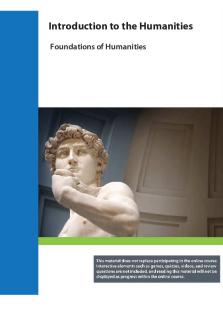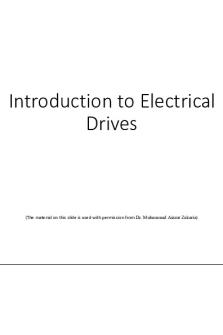MODULE 1: INTRODUCTION TO PHARMACOGNOSY PDF

| Title | MODULE 1: INTRODUCTION TO PHARMACOGNOSY |
|---|---|
| Author | Jose Philip Maglalang |
| Course | Organic Chemistry |
| Institution | Angeles University Foundation |
| Pages | 5 |
| File Size | 149.9 KB |
| File Type | |
| Total Downloads | 125 |
| Total Views | 333 |
Summary
PHARMACOGNOSY Derived from two Greek words: Pharmakon means ‘drug’ & Gnosis means ‘knowledge’. Pharmacognosy means ‘knowledge of drugs’ Pharmacognosy may be defined as an important branch of Pharmacy which deals with the study of structural, physical, chemical, biochemical and sensory charac...
Description
PHARMACOGNOSY AND PLANT CHEMISTRY
PHARMACOGNOSY • Derived from two Greek words: Pharmakon means ‘drug’ & Gnosis means ‘knowledge’. • Pharmacognosy means ‘knowledge of drugs’ • Pharmacognosy may be defined as an important branch of Pharmacy which deals with the study of structural, physical, chemical, biochemical and sensory characters of natural drugs of plant and animal origin. • The branch of knowledge concerned with medicinal drugs obtained from plants or other natural sources SCOPE OF PHARMACOGNOSY • Pharmacognosy deals primarily with information on the sources and constituents of natural drugs. o Primary source of medicines (from ancient time to present day), for example – hyoscine, morphine, ergotamine, ouabain etc. o Providing Template/guide for the discovery of new drugs, for example – Pathidine (analgesic drug) designed from morphine. HISTORY • In order to gain proper perspective about a science that deals with plant and animal drugs and their constituents, it is exceedingly helpful to survey past records and to recognize those who have contributed to the subject matter that constituted the field of pharmacognosy • Babylonians o Made clay models of the human body, and early writings indicate that they were aware of the medicinal effects of a number of plants. • Egyptians o Were adept at embalming the dead and that they possessed an understanding of the human anatomy as well as a knowledge of the medicinal uses of many plants and animals according to o Papyrus Ebers Egyptian compilation of medical texts dated about 1550 bc, one of the oldest known medical works that was found in the tomb of a mummy. The scroll contains 700 magical formulas and folk remedies meant to cure afflictions ranging from crocodile bite to toenail pain and to rid the house of such pests as flies, rats, and scorpions. Discovered by Georg Ebers • Pedanius Dioscorides o Greek physician and pharmacologist o Author of De Materia Medica (first-hand account of various plants used in medicine) o Described more than 600 species of plants o Wrote an extensive guide to pharmacy and medical botany. He included details of plant habitat and methods of growing and harvesting plants, as well as their medical usage and dosage. ▪ Aloe, belladonna (atropine), colchicum (colchicine), ergot (ergotamine), hvoscamus (hyoscine), and opium (opioids) • Claudius Galen o Father of Pharmaceutical Compounding o Greek pharmacist-physician o Described the method of preparing formulas containing plant and animal drugs.
JOSE PHILIP G. MAGLALANG, RPh
1
PHARMACOGNOSY AND PLANT CHEMISTRY
Devoted considerable time to compiling this knowledge, which was distributed throughout 20 hooks. o As a tribute to his accuracy in recording his observations Galenical pharmacy was originated. • CA Seydler o Medical student in Halle/Saale, German o Coined or introduce pharmacognosy from “pharmakon - drug” & “gnosis - knowledge” • JA Schmidt o First to use the word pharmacognosy o Used the term in his Lehrbuch der materia medica in1811, to describe the study of medicinal plants and their properties • Friedrich August Flückiger o Presented most comprehensive idea of the scope of pharmacognosy “the simultaneous application of various scientific disciplines with the object of acquiring knowledge of drugs from every point of view.” TERMS IN PHARMACOGNOSY • Crude Drug is a natural drug of plant or animal origin which has undergone no treatment other than collection and drying, that is, the quality or appearance of the drug has not been advanced in value or improved in condition by any physical or chemical treatment. o Used infrequently as therapeutic agents. • Natural substances have not had changes made in their molecular structure as found in nature • Derivatives/ Extractives chief constituents obtained by extraction • Menstruum A naturally-derived substance used as a solvent to extract compounds from plant material when making herbal extractions or preparations. (a substance that dissolves a solid or holds it in suspension) • Marc the undissolved portion of the drug that remains after extraction. • Phytochemicals Defined as bioactive compounds, which can be extracted from foods or foods by-products, and able to regulate metabolic functions leading to beneficial effect o Found in different parts of plant (fruit, flower, stem, leaf, root) o The chemicals are often referred to as secondary metabolites, of which there are several classes including alkaloids, anthraquinones, coumarins, fats, flavonoids, glycosides, gums, iridoids, mucilages, phenols, phytoestrogens, tannins, terpenes, terpenoids, and others. • Indigenous Plants growing in their native countries • Naturalized Plants that when they grow in a foreign land or in a locality other than their native homes. GENERAL PROCESS OF EXTRACTION • Extraction is the first step to separate the desired natural products from the raw materials. 1. The solvent penetrates into the solid matrix 2. The solute dissolves in the solvents 3. The solute is diffused out of the solid matrix 4. The extracted solutes are collected. o
JOSE PHILIP G. MAGLALANG, RPh
2
PHARMACOGNOSY AND PLANT CHEMISTRY
Preparation of Drugs in the Commercial Market Collection • Collection is the most important step which comes after cultivation. Drugs are collected from wild or cultivated plants and the tasks for collection depends upon the collector, whether he is a skilled or unskilled labor. Drugs should be collected when they contain maximum amount of constituents in a highly scientific manner. • Collecting data/information • Ensuring the natural source of the drug Harvesting • Harvesting is an important operation in cultivation technology, as it reflects upon economic aspects of the crude drugs. • An important point which needs attention over here is the type of drug to be harvested and the pharmacopoeial standards which it needs to achieve. • Harvesting can be done efficiently in every respect by the skilled workers. • Manual labor vs. mechanical devices Drying • Drying consists of removal of sufficient moisture content of crude drug, so as to improve its quality and make it resistant to the growth of microorganisms. • Drying fixes, the constituents, facilitates grinding and milling, and converts the drug into a more convenient form for commercial handling. • Drying inhibits partially enzymatic reactions. • Drying methods: o Natural o Air drying, sun drying, shade drying o Artificial Heat o Oven 40-60 0C Garbling • Garbling is the final step in the preparation of a drug. • It consists of the removal of extraneous matter, such as other parts of the plant, dirt, and added adulterants. • This step is done to some extent during collection, but should he carried out after the drug is dried and before it is baled or packaged. Packaging, Storage & Preservation • The packaging of drugs is dependent upon their final disposition. • Packaging should provide protection to the drug as well as give economy in space. • Proper storage and preservation are important. • Warehouses preferably should be of fire proof, unheated and rodent proof • Exposure of the drugs to a temperature of 65 degree Celsius to prevent the of insect attacks EVALUATION OF DRUGS • Determine the quality (intrinsic property) and purity (absence of adulterants) of drugs. • The evaluation of a drug involves a number of methods, which may be classified as follows • Organoleptic evaluation
JOSE PHILIP G. MAGLALANG, RPh
3
PHARMACOGNOSY AND PLANT CHEMISTRY
The study of a drug with the help of organs of sense. It includes any drug’s macroscopic or external appearance, color, odor, taste & sounds of its fracture etc. o The macroscopic or external characteristic of a drug Microscopic evaluation o Can be done in the laboratory by the use of microscopes and utilizes various microscopic characters of the drugs, such as types and arrangement of various cells and tissues. o The identification of the pure powdered drug. Chemical evaluation o Involves both qualitative and quantitative determination of their active principles in determining official potency o In this method characteristic qualitative chemical tests are employed to identify crude drugs and their constituents. Biological evaluation o Used in determining the pharmacological activity of the drug o Since living organism or their isolated living tissues are used, this method is also called the biological o method or bioassay. o Many drugs, particularly the antibiotics, toxins and toxoids and also vitamins are assayed by this method. Physical evaluation o Accomplished by the determination of various physical characteristics using various physico-chemical techniques. o Example, specific gravity (of fats and volatile oils), melting points (of alkaloids), optical rotation (of alkaloid and volatile oils), etc. o o
•
•
•
•
CLASSIFICATION OF DRUG PRODUCTS In pharmacognosy, drugs may be classified according to: Morphology • The drugs are grouped according to the part of the plant or animal represented, such as roots, leaves, organs, or glands. Taxonomy • Consideration of the natural relationship or phylogeny Therapeutic applications • This type of consideration forms the basis for the science of pharmacology Chemical constituents • Based on active constituents • Preferred method of classification - more specific than pharmacological CHEMISTRY OF DRUGS Active constituent • Compounds responsible for the therapeutic effect • Classes of Active Constituents
JOSE PHILIP G. MAGLALANG, RPh
4
PHARMACOGNOSY AND PLANT CHEMISTRY
Pharmacologically active responsible for the therapeutic activity of the drug. May be a single chemical substance or a mixture. o Pharmaceutically active - may cause precipitation or other chemical changes in a medicinal preparation Inert constituents • Chemical compounds which do not possess any definite therapeutic values as such but are useful as an adjunct either in the formulation of a drug. Biogenesis • One phase of pharmacognosy that has assumed a role of importance in recent years • The study of the biochemical pathways leading to the formation of secondary constituents used as drugs. FACTORS AFFECTING BIOGENESIS Ontogeny or Stage of Development • Concentration of drug change along with the age of plant Heredity Environment o
REFERENCES: • Evans, W. C., Evans, D., & Trease, G. E. (2009). Trease and Evans pharmacognosy (16th ed.). Edinburgh; New York: Saunders/Elsevier. • Tyler, V. E., Brady, L. R., Robbers, J. E., & Claus, E. P. (1976). Pharmacognosy. Philadelphia: Lea & Febiger.
JOSE PHILIP G. MAGLALANG, RPh
5...
Similar Free PDFs

Introduction to Pharmacognosy
- 10 Pages

Module 1 -Introduction to Research
- 15 Pages

Module 1 Introduction To Mechanics
- 11 Pages

Pharmacognosy
- 97 Pages

Introduction to Law Module Handbook
- 24 Pages

PCM-module 1-Introduction
- 3 Pages
Popular Institutions
- Tinajero National High School - Annex
- Politeknik Caltex Riau
- Yokohama City University
- SGT University
- University of Al-Qadisiyah
- Divine Word College of Vigan
- Techniek College Rotterdam
- Universidade de Santiago
- Universiti Teknologi MARA Cawangan Johor Kampus Pasir Gudang
- Poltekkes Kemenkes Yogyakarta
- Baguio City National High School
- Colegio san marcos
- preparatoria uno
- Centro de Bachillerato Tecnológico Industrial y de Servicios No. 107
- Dalian Maritime University
- Quang Trung Secondary School
- Colegio Tecnológico en Informática
- Corporación Regional de Educación Superior
- Grupo CEDVA
- Dar Al Uloom University
- Centro de Estudios Preuniversitarios de la Universidad Nacional de Ingeniería
- 上智大学
- Aakash International School, Nuna Majara
- San Felipe Neri Catholic School
- Kang Chiao International School - New Taipei City
- Misamis Occidental National High School
- Institución Educativa Escuela Normal Juan Ladrilleros
- Kolehiyo ng Pantukan
- Batanes State College
- Instituto Continental
- Sekolah Menengah Kejuruan Kesehatan Kaltara (Tarakan)
- Colegio de La Inmaculada Concepcion - Cebu









